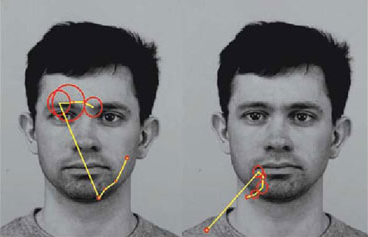How do people with ASD differ in social processing?

People with ASD can show deficits in all areas of social processing: attaching social meaning, being socially motivated, and performing the right social behavior in the right social context. By 8–10 months old, babies at risk of ASD are less likely to respond to their names; by 12 months, they look at faces less than other babies do.1 Numerous studies have shown that people with ASD have difficulty judging facial expressions. By pre-school, children with ASD show no change in brain waves (called event-related potentials, or ERPs) when comparing familiar versus unfamiliar faces, faces versus objects, or fearful versus neutral faces.
People with ASD also look at faces differently. As shown in the figure, unlike neurotypical people, who focus their eyes primarily on the eyes and secondarily on the mouth (left), people with ASD pay less attention to the eyes (right). Brain areas involved in facial recognition and processing, such as the fusiform gyrus, were found to be significantly less active in people with ASD than in neurotypical people.2
| References: |
|

